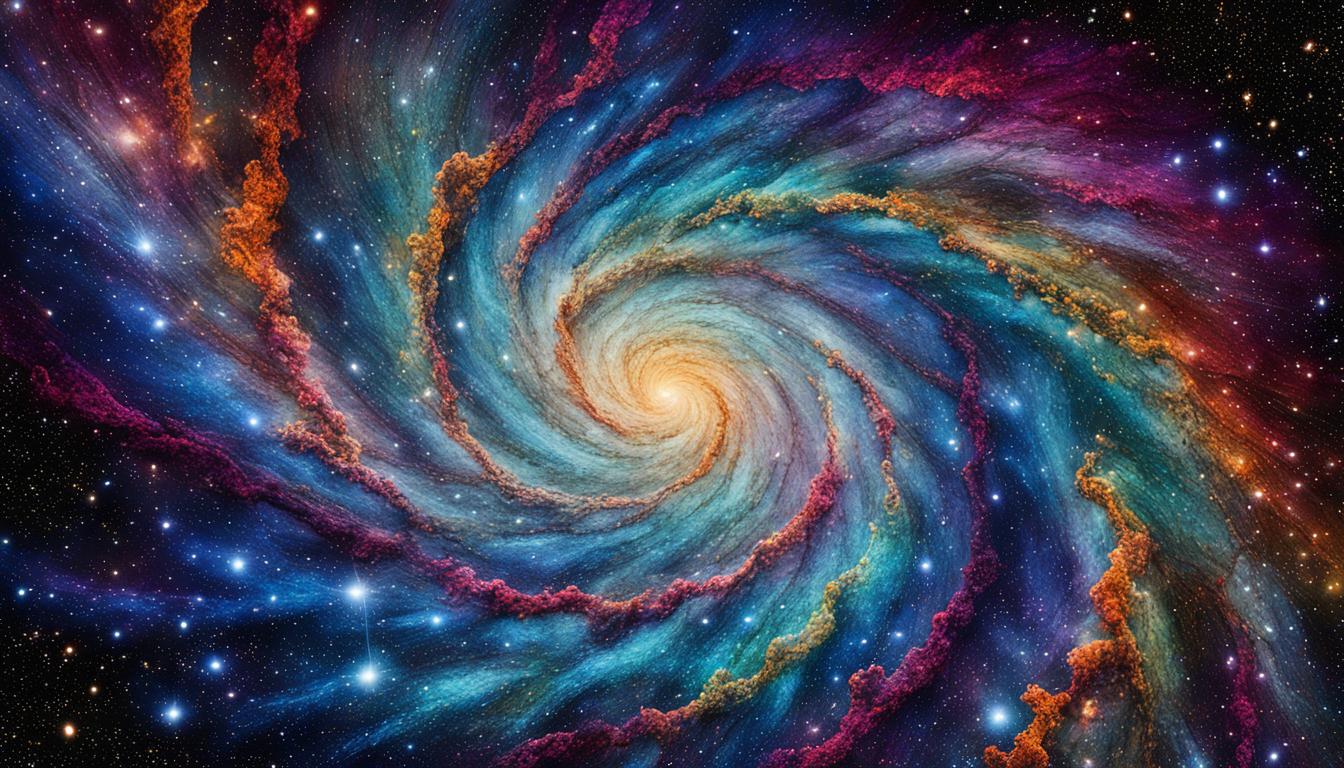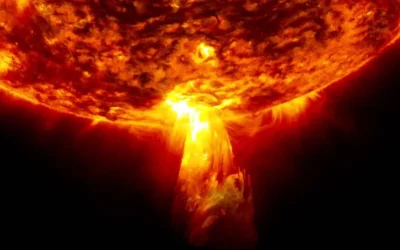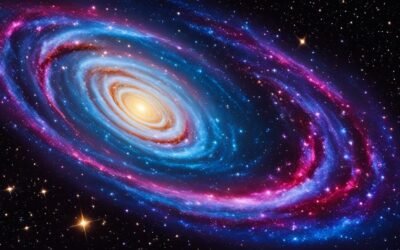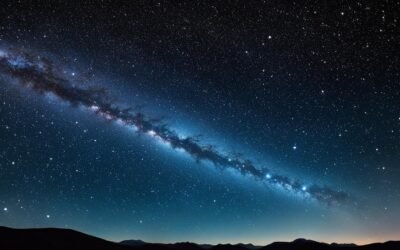In your journey through the cosmos, you’ll encounter the phenomenal Virgo Cluster—a celestial marvel comprised of an awe-inspiring collection of galaxies within our own cosmic neighborhood. Seated in the constellations of Virgo and Coma Berenices, this colossal cluster serves as an aggregation point for approximately 1,300 to 2,000 galaxies, each spinning its own ancient tale in the tapestry of the universe. Situated around 53.8 million light-years away, the gravitational reach of the Virgo Cluster extends far and wide, exerting a potent influence that even alters the trajectory of our Local Group of galaxies.
Beyond its sheer size and mass, the Virgo Cluster is home to some of the heavens’ most renowned residents, including Messier 49 with its blazing intensity and, more famously, Messier 87—a behemoth elliptical galaxy cradling a supermassive black hole that stands at the cluster’s heart. This gravitational giant does not just anchor the cluster but also pulls you to explore the profound depths of its cosmic mysteries.
Key Takeaways:
- The Virgo Cluster sits within the constellations Virgo and Coma Berenices, acting as a principal structure in our cosmic vicinity.
- Its center is posited at a distance of about 53.8 million light-years from Earth, making its study more accessible to astronomers.
- Amassing roughly 1,300 to 2,000 member galaxies, it exhibits a significant gravitational pull within the cosmos.
- Messier 87, the cluster’s most eminent galaxy, is noted for its supermassive black hole, which lends insight into the nature of galactic cores.
- The Virgo Cluster’s mass contributes to the Virgocentric flow, affecting the motions of the surrounding galaxies including our Local Group.
- The diversity and sheer number of galaxies in the Virgo Cluster make it an ideal laboratory for understanding the evolution of galaxies and the large-scale structure of the universe.
Exploring the Cosmic Vastness of the Virgo Cluster
As your gaze lifts to the night sky, the Virgo Cluster serves as a stunning reminder of the cosmic vastness and the place our Milky Way holds within it. Unlocking the secrets of this celestial structure offers insights into the grand tapestry of the universe.
Composition and Scale: A Glance at the Galaxy Count
Inhabiting the heart of the Virgo Cluster is an array of both towering and diminutive galaxies. This vast assemblage, rich in variety, paints a vivid picture of the cluster’s structure. Within this cosmic community, galaxies come in all sizes, from the impressive large ellipticals down to countless smaller dwarf galaxies—a testament to the diversity woven into the fabric of the universe.
The Role of Messier 87: Understanding the Largest Galaxy
Messier 87 (M87), the largest galaxy within the Virgo Cluster, stands out as an astronomical beacon in our understanding of celestial phenomenons. This gargantuan elliptical galaxy, home to a supermassive black hole, anchors the cluster with its gravitational might. The iconic imagery of its event horizon represents a breakthrough in our comprehension of these cosmic giants.
| Feature | Description | Implications |
|---|---|---|
| Messier 87’s Core | A supermassive black hole | Affirms theories of galactic evolution and black hole dynamics |
| Intracluster Medium | X-ray-emitting plasma | Provides clues to the cluster’s formation and temperature distributions |
| Stellar Content | Myriad Stars | Offers a window into the history and lifecycle of galaxies |
Virgo Cluster’s Placement in the Expansive Universe
The Virgo Cluster, a sprawling mass of celestial bodies, holds a critical station in the expansive universe. It represents not just a collection of galaxies, but a major landmark that helps astronomers trace the large-scale structure of the cosmos. Your understanding of space’s vastness is greatly enriched by comprehending the sheer scope and scale of this mighty cluster of galaxies.
Zooming into the Heart of the Virgo Supercluster
As you embark on a journey to the center of the cosmic region known as the Virgo Supercluster, you’ll find the heart of the Virgo Cluster pulsating with the gravitational rhythms that orchestrate the motion of countless galaxies. This core area is not just a spectacular confluence of celestial bodies but also a focal point of immense gravitational force that shapes the architecture of our universe.
Delve into this pivotal cosmic neighborhood and you’ll discover the intricate complexities of galactic interactions. It is here, in this densely populated region of space, where galaxies are drawn together by the cluster’s gravity, creating a symphony of orderly chaos. The heart of the Virgo Supercluster, therefore, is crucial for understanding the gravitational dynamics not just of itself, but also of the surrounding galaxy groups, including our own Local Group.
The Virgo Cluster’s contribution to the Virgocentric flow highlights its imposing presence within the supercluster. This flow sees galaxies in the Local Supercluster, including our Milky Way, moving at a slowed pace due to the mass and gravity of the Virgo Cluster at its core. The cosmic dance orchestrated by these forces provides invaluable insights into the nature of the universe’s grand structure.
With every observation and study, your perception of this grand cosmic region expands, unearthing the cluster’s influence on its intergalactic neighbors. Indeed, the Virgo Cluster is significantly more than a collection of galaxies but a beacon that illuminates our path to comprehending the universe’s expansive design.
The Diverse Galactic Assembly of the Virgo Cluster
When you gaze into the night sky at the galaxies in the Virgo Cluster, you’re observing a spectacular galactic assembly. Each galaxy is like a piece of an astronomical puzzle, contributing to the cluster’s majesty and might. The cluster’s vast array of spiral and elliptical galaxies is not only a feast for the eyes of astrophiles but is of paramount importance to scientists dissecting the fabric of our cosmos.
Spiral Versus Elliptical: Varied Galaxy Structures
The two primary types of galaxies found within the Virgo Cluster, spiral and elliptical, present a stark contrast in form and configuration. Spirals, with their winding arms and active star-forming regions, sprawl across the cluster in an extended filament which reflects the dynamic and aesthetic aspect of galactic assembly. On the other hand, the more massive ellipticals are grouped nearer to the cluster’s gravitational center, their burgeoning mass and aged stars telling a different story of cosmic evolution.
The differences between these galaxy types do not end at their shapes. Spirals often harbor younger stars and are generally less dense than their older, more compact elliptical counterparts. This variety is essential for understanding the evolutionary processes that govern galactic formation and behavior, offering clues to the past and future of such conglomerates.
Subclusters Within: Comprehending the Internal Formation
The Virgo Cluster’s internal formation is far from monolithic. Instead, it’s composed of several subclusters that range vastly in size and mass – each a unique substructure with its own narrative. Virgo A, centering around the mighty M87, stands out as the most massive, while Virgo B, orchestrated around M49, offers a different cosmic concoction. The potential existence of Virgo C further illustrates that this cluster is an ongoing symphony of galactic convergence, still in the inexorable process of assembly.
- Virgo A – Dominated by the giant elliptical galaxy M87, a heavyweight influencing its neighbors through immense gravitational pull.
- Virgo B – With M49 at its heart, this subcluster is an intricate galactic community showcasing the cluster’s diversified personality.
- Virgo C – Though its presence is still under scrutiny, it adds to the mystery and complexity of the cluster’s overall architecture.
What you’re witnessing in the Virgo Cluster is nothing short of a grand astronomical ballet. The dance of galaxies— from spiral to elliptical, from individual stars to entire galactic clusters—provides us with a front-row seat to the ongoing narrative of our universe’s galactic assembly. It’s a living testament to the immense scales and forces at play within the cosmos we call home.
Estimating the Astounding Distance to the Virgo Cluster
When you gaze up at the night sky, you behold a vast expanse that cannot be quantified easily. Among the celestial entities that have captivated astronomers is the Virgo Cluster. Situated some 53.8 million mega light-years away, understanding its distance is not merely an exercise of curiosity but a foundational element in cosmic measurement. This measurement of distance to the Virgo Cluster has profound implications for the study of astrophysics, providing a basis for the calibration of distances to other far-flung regions of the universe.
Let’s break down how these measurements contribute to our cosmic knowledge:
- The apparent magnitude of galaxies within the Virgo Cluster gives us a glimpse into their intrinsic luminosity.
- Redshift measurements help us understand the rate at which the universe is expanding.
- An accurate assessment of the distance to the Virgo Cluster refines our extragalactic distance ladder.
Mega light-years may wrap your mind in conceptual knots, but these units of distance provide a remarkable cosmic yardstick. Below is an essential table that compares the Virgo Cluster with other cosmic structures, emphasizing its relatively close proximity to Earth and its significance in anchoring astronomical measurements.
| Cosmic Structure | Distance from Earth (Mega Light-Years) | Significance to Observation |
|---|---|---|
| Virgo Cluster | About 53.8 | Closest large scale galaxy cluster; pivotal for calibrating intergalactic distances. |
| Andromeda Galaxy | Approximately 2.5 | Nearest spiral galaxy; benchmarks measurements within the local group. |
| Coma Cluster | About 326 | One of the nearest rich galaxy clusters; offers a global scale reference. |
| Hydra Cluster | About 167 | Provides insight into cluster dynamics and dark matter distribution. |
As your eyes venture through the depths of space, bear in mind the incredible distance measurements that render these views meaningful. The Virgo Cluster is within our grasp, comparatively, providing a significant touchstone for unraveling the puzzles of our universe. Indeed, such measurement offers a testament to human ingenuity in piercing the veils of cosmic scale.
Remarkable Virgo Cluster Facts and Discoveries
As you delve deeper into the mysteries of the cosmos, the Virgo Cluster emerges as a source of profound astrophysical discoveries. Not only does its significant mass affect the dynamics of neighboring galaxies, but it also plays a pivotal role in the trajectory of our very own Milky Way.
The Intriguing Phenomenon of Virgocentric Flow
One of the most fascinating aspects is the Virgocentric flow, a direct manifestation of the cluster’s gravitational stronghold. This flow alters the recessional movement of galaxies within the Local Group, thus providing invaluable data for astrophysics research. The Virgo Cluster interplays with the fabric of space to dictate the cosmic dance of galaxies, a dance the Milky Way participates in.
Milky Way’s Connection to the Virgo Cluster
Your home galaxy is not immune to the gravitational bonds of the Virgo Cluster. This connection signifies a gravitational link that further accentuates the importance of the Virgo Cluster in understanding our universe’s grand architecture. By studying such relationships, scientists gain insights into the forces that shepherd galaxies across the cosmic expanse.
| Aspect | Virgo Cluster | Milky Way |
|---|---|---|
| Galaxy Type | Cluster of Galaxies | Barred Spiral Galaxy |
| Mass Influence | Exerts Gravitational Forces | Experiences Gravitational Effect |
| Star Formation | Inhibited in Cluster’s Core | Ongoing in Spiral Arms |
| Role in Virgocentric Flow | Source of Gravitational Pull | Affected by Gravitational Pull |
Discoveries such as the hindrance of star formation within certain galaxies of the Virgo Cluster, due to the stripping of molecular gases, provide a stark contrast to the vibrant, star-forming regions of the Milky Way. Charting out and understanding these differences not only satisfy your cosmic curiosity but also sharpen the overall picture of how galaxy clusters, like Virgo, can influence the evolutionary path of their inhabitants, including the galaxy you call home.
Virgo Cluster: A Pivotal Subject in Modern Astronomy
Embarking on research on the Virgo Cluster is like delving into a treasure trove for those passionate about modern astronomy. Positioned as a pivotal subject, the Virgo Cluster acts as a vital laboratory, presenting unprecedented opportunities for groundbreaking studies about galaxies and their evolution. Uncover the layers of cosmic history and revolutionize your understanding of space as you explore this celestial phenomenon.

The significance of the Virgo Cluster extends beyond its impressive composition; it’s a cornerstone for anchoring the cosmological distance scale. Through diligent study, astronomers establish critical mileposts across the universe, allowing them to chart distances with remarkable precision. Your journey into extragalactic astronomy begins here, with the Virgo Cluster demonstrating the nuanced ballet of galaxy formation and the meticulous construction of cosmic structures.
Let’s explore some compelling statistics that might intrigue any avid observer of the cosmos:
| Characteristic | Description |
|---|---|
| Location | Virgo and Coma Berenices constellations |
| Member Galaxies | Approximately 1,300 to 2,000 |
| Mass | Around 1.2×10^15 solar masses |
| Radius | Approximately 2.2 megaparsecs from center |
| Central Galaxy | Messier 87 with a supermassive black hole |
| Luminous Galaxy | Messier 49 |
| Known For | Central role in defining the cosmological distance scale |
As you immerse yourself in the complexities of modern astronomy, consider the Virgo Cluster not just as a cosmic entity, but as a cornerstone that enhances our comprehension of the vast universe. With each research endeavor, the pieces of the cosmic puzzle fall into sharper relief, affording you a clear vision of the intricate tapestry of the celestial realm.
Unraveling the Structure of the Virgo Cluster
The Virgo Cluster, a prominent structure in our cosmic neighborhood, is not as uniform as one might imagine. Instead, it presents a fascinating tapestry of various galaxy types and compositions, hinting at the complex processes that govern their behaviors and interactions. To truly appreciate the Virgo Cluster’s structure, one must delve into the rich subtleties of its subclumps and intragalactic interactions.
Subclumps and Density Profiles: The Dynamic Complexity
The sheer scale of the Virgo Cluster becomes apparent when considering its multiple subclumps, each with distinct characteristics and evolution. These subclusters are the building blocks of the larger structure, merging and interacting in a cosmic dance that has been ongoing for billions of years. The differences among these subclumps are not merely in their appearance, but also in their density profiles, which can tell us much about the cluster’s history and future.
| Subcluster Name | Main Constituent Galaxies | Notable Characteristics |
|---|---|---|
| Virgo A | M87 (Messier 87) | Centrally located, contains a massive black hole |
| Virgo B | M49 (Messier 49) | Rich in spiral galaxies, less dense |
| Virgo C* | NGC 4424, NGC 4501 | Still under investigation, potentially a distinct subclump |
Intragalactic Interactions and Their Consequences
The dynamism of the Virgo Cluster is further exemplified by the myriad of intragalactic interactions occurring within its confines. As galaxies weave through the cluster environment, they encounter forces such as ram pressure stripping, which can strip them of their gas and halt star formation, effectively changing the course of their evolution. Understanding these interactions is crucial for piecing together the life cycle of galaxies within such a turbulent neighborhood.
Through persistent observation and analysis, the structure of the Virgo Cluster ceases to be an enigma, transforming into a finely detailed map of celestial interactions and histories.
Investigating the Influence of the Virgo Cluster
As you delve deeper into the cosmic intricacies of our universe, the Virgo Cluster emerges as a monumental force influencing a wide array of astronomic phenomena. Its gravitational pull not only binds together a myriad of galaxies but also reaches out to nudge the trajectory of our own Local Group. This celestial gravitas is one of the key factors in understanding the ongoing dance of the cosmos.
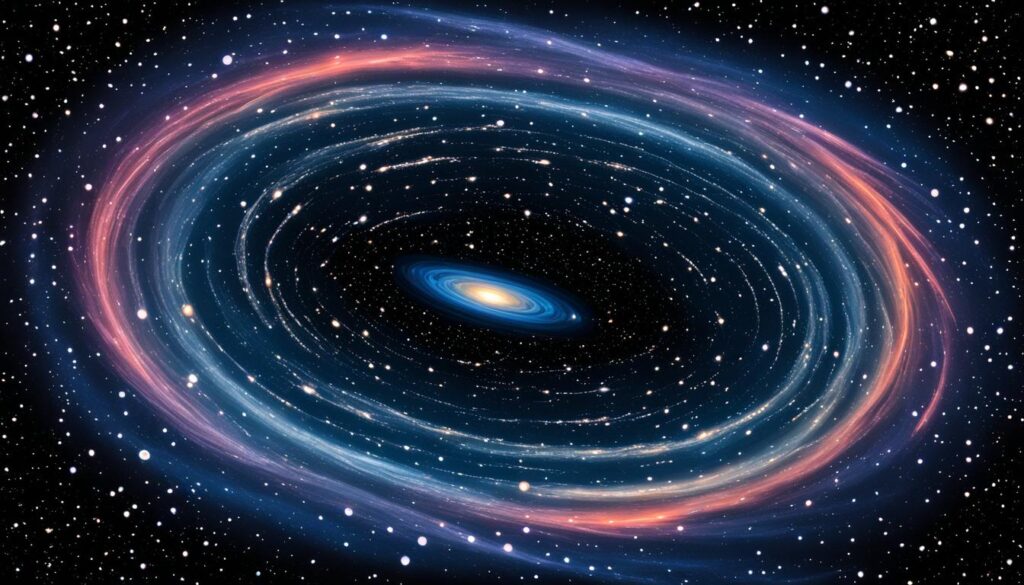
Gravitational Pull and Its Effects on Cosmic Phenomena
The gravitational pull exerted by the Virgo Cluster extends well beyond the physical boundaries of its member galaxies. This colossal attraction shapes the motions of galaxies within in a phenomenon known as the Virgocentric flow. Imagine an invisible tether, anchoring galaxies and subtly reeling them in, altering their paths across the cosmic expanse. It is this gravitational relationship that explains the anomalous velocities seen in our Local Group, as even the mighty Milky Way feels the gravitational embrace of the Virgo Cluster.
Supermassive Black Holes and Galactic Evolution
At the apex of the Virgo Cluster’s influence are the supermassive black holes residing in its galaxies. The most famous of these cosmic leviathans is nestled in the core of M87, driving research into the nexus between black holes and galactic evolution. These astonishing entities, millions to billions times the mass of our sun, do much more than merely warp spacetime—they regulate the birth and death of stars, dictate the growth of galaxies, and draft the framework of the cosmos itself. The influence of the Virgo Cluster, as evidenced by these supermassive black holes, provides a profound understanding of our universe’s past and a glimpse into its future.
Insights from Ongoing Research on the Virgo Cluster
The realm of extragalactic studies is continuously energized by ongoing research on the Virgo Cluster, one of the seminal subjects within observational astronomy. Utilizing state-of-the-art technology and methodologies, astronomers delve deeply into its multifaceted components to enhance our cosmic comprehension.
Particular attention is paid to the likes of NGC 4654, an intermediate spiral galaxy that serves as a case study for the intricate dance between galactic structures and the interstellar medium. Here, researchers investigate the fascinating processes such as ram pressure stripping, which affect the formation of stars and the evolution of galaxies within this massive celestial collective.
To truly appreciate the scope of scholarly pursuit in this cosmic sector, consider these transformative aspects fueling our cosmic curiosity:
- Analysis of the gravitational intricacies influencing galaxy motion and interaction
- Study of star formation rates in relation to environmental factors within the cluster
- Examination of the roles that supermassive black holes play in the evolution of galaxies
The Virgo Cluster’s contribution to our understanding of the universe is monumental. Its proximity and richness in diverse galactic specimens make it an ideal target for observational astronomy.
As the subject of ongoing research on the Virgo Cluster expands, we stand on the precipice of new discoveries that promise to elucidate the workings of our incredible cosmic neighborhood.
Instrumental in this research is the Hubble Space Telescope, a veritable eye in the sky, translating electromagnetic narratives into a tapestry of data for scientists to decode. This continuous stream of information is paramount in constructing a more cohesive model of the cluster’s dynamics and its component galaxies.
Join us in marveling at the visual splendor provided by this observational astronomy powerhouse:
Below is a snapshot of current focal points within the Virgo Cluster research:
| Area of Study | Description | Impact |
|---|---|---|
| Galactic Interactions | Inspection of gravitational effects and collisional dynamics between galaxies | Enhances understanding of galaxy evolution and cluster formation |
| Interstellar Medium Research | Exploration of gas and dust distribution, their properties, and movement within galaxies | Provides clues about star formation and the role of the intracluster medium |
| Dark Matter Distribution | Mapping of dark matter within the cluster through gravitational lensing techniques | Sheds light on the unseen mass that governs the structure of the cluster |
The keys to unlocking the mysteries of the Virgo Cluster—and by extension, the universe—lie in the assiduous study of these and other astronomical phenomena. What we learn from the ongoing research on the Virgo Cluster paves the way for future explorations far beyond our current horizon.
Traversing the Galaxies in the Virgo Cluster
As an enthusiast of the cosmos, your journey through the celestial marvels of the Virgo Cluster is replete with astronomical treasures. Among the assembly of galaxies, certain luminaries such as Messier 49, Messier 86, and NGC 4216 emerge as paragons within this cosmic neighborhood. Each harbors unique attributes and histories, contributing richly to the tapestry of our universe.
Messier 49, Messier 86, NGC 4216: Noteworthy Members
The galaxies in Virgo Cluster exhibit a variety of structures and phenomena, with each offering insights into the cosmic puzzle. Messier 49, the brightest, beckons with its majestic presence, while Messier 86 stands out with its remarkable high-velocity rush towards us. NGC 4216, a spiral marvel, adds depth to the celestial vista with its edge-on orientation and prominent dust lanes. These galaxies are not just points of light but compasses guiding us through the cluster’s vast domain.
Telescope Views: Witnessing the Virgo Cluster’s Splendor
Thanks to the power of telescope views, the grandeur of the Virgo Cluster unveils itself. From backyard telescopes to the might of observatories, the sights captured are nothing short of awe-inspiring. Aspiring astronomers and seasoned observers alike share the revelatory experience of witnessing galactic collisions, starburst fireworks, and the serene dance of celestial bodies. Each observation adds a stroke to the ever-evolving portrait of our universe and secures your connection to the cosmos.
FAQ
What exactly is the Virgo Cluster, and why is it significant?
The Virgo Cluster is a massive collection of 1,300 to 2,000 galaxies located in the Virgo and Coma Berenices constellations. It’s significant because it is the nearest major galaxy cluster to the Milky Way, allowing astronomers to study its structure, composition, and the gravitational forces it exerts, providing insights into the workings of the universe.
How far is the center of the Virgo Cluster from Earth?
The center of the Virgo Cluster is approximately 53.8 million light-years away from Earth. This relatively close proximity provides an excellent opportunity for detailed astronomical research and observations.
What is the role of Messier 87 in the Virgo Cluster?
Messier 87 (M87) is the most massive galaxy within the Virgo Cluster. It harbors a supermassive black hole at its center, which became famous after the first image of a black hole was taken by the Event Horizon Telescope in 2019. M87 plays a key role in the gravitational dynamics and overall structure of the cluster.
Can you explain what the Virgo Supercluster is?
The Virgo Supercluster, also known as the Local Supercluster, is an enormous cosmic structure that includes the Virgo Cluster at its heart. Our own Milky Way galaxy is part of this larger supercluster, which comprises many galaxy clusters, including the Virgo Cluster.
What types of galaxies make up the Virgo Cluster, and how are they distributed?
The Virgo Cluster contains a rich diversity of galaxy types, including spirals, ellipticals, and irregulars. Large elliptical galaxies like M87 are found near the cluster’s center, while spiral galaxies are more spread out, indicating a filament structure. The cluster’s galaxies vary in size and brightness, creating a dynamic and complex assembly.
What are the internal formations within the Virgo Cluster?
The Virgo Cluster is made up of at least three subclusters—Virgo A, Virgo B, and potentially Virgo C—as well as additional galaxy clouds. These subclusters have various densities and are in different stages of merging and evolving, making the internal structure of the Virgo Cluster quite intricate.
What is the Virgocentric flow, and what does it reveal about the Virgo Cluster?
The Virgocentric flow refers to the observed slowing down of galaxies as they move towards the Virgo Cluster due to its immense gravitational pull. This phenomenon is evidence of the cluster’s mass and its gravitational influence on neighboring galaxies, including those in the Local Group, such as the Milky Way.
How does the Milky Way connect to the Virgo Cluster?
The Milky Way is part of the Local Group, a smaller galaxy cluster that is being gravitationally influenced by the Virgo Cluster. The interaction between the Local Group and the Virgo Cluster is part of the larger dynamics within the Virgo Supercluster.
What have we learned from research on the Virgo Cluster?
Research on the Virgo Cluster has provided critical insights into galaxy formation, evolution, and the distribution of dark matter. Studies have also helped delineate the cosmological distance scale and expanded our understanding of the large-scale structure of the universe.
Can you describe the dynamic complexity of the Virgo Cluster’s structure?
The Virgo Cluster exhibits dynamic complexity through its subclumps, each composed of different galaxy types and densities. The interactions among these subclusters contribute to the overall gravitational architecture and future evolution of the cluster.
What are the consequences of intragalactic interactions within the Virgo Cluster?
Intragalactic interactions within the Virgo Cluster, such as galaxies colliding or passing near each other, can strip gas away from galaxies, disrupt star formation, and sometimes trigger the formation of new stars. These interactions refine our theories on galactic development and the impact of environment on galaxy evolution.
What effects does the Virgo Cluster’s gravitational pull have on cosmic phenomena?
The gravitational pull of the Virgo Cluster influences the velocity and trajectory of nearby galaxies, including galaxy rotation and interactions. Such profound gravitation can cause phenomena such as the aforementioned Virgocentric flow and may also have consequences on the growth and behavior of supermassive black holes within the cluster’s galaxies.
How do supermassive black holes within the Virgo Cluster impact galactic evolution?
Supermassive black holes, particularly the one in M87, significantly influence the energy output, galactic dynamics, and matter distribution within their host galaxies. They can potentially regulate the rate of star formation and contribute to the evolution of galaxies within the Virgo Cluster.
What does ongoing research on the Virgo Cluster focus on?
Ongoing research on the Virgo Cluster aims to understand the properties and distribution of dark matter, the interaction of galaxies within the cluster, star formation processes, and the effects of the intracluster medium on galaxy evolution. This research utilizes advanced telescopes and observational techniques to gather data.
Are there any particularly noteworthy galaxies in the Virgo Cluster?
Yes, the Virgo Cluster boasts several noteworthy galaxies, such as Messier 49 (M49), Messier 86, and NGC 4216. These galaxies are of particular interest to astronomers due to their size, brightness, and the unique physical processes occurring within them.
How can amateur astronomers view the Virgo Cluster?
Amateur astronomers can observe the Virgo Cluster using moderate-size telescopes, which can reveal some of the cluster’s brightest galaxies. On clear nights away from city lights, even smaller telescopes or binoculars may capture some of the more significant members of this celestial marvel.



